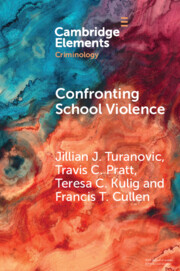Element contents
Confronting School Violence
Published online by Cambridge University Press: 18 March 2022
Summary
Information
- Type
- Element
- Information
- Series: Elements in CriminologyOnline ISBN: 9781108891998Publisher: Cambridge University PressPrint publication: 05 May 2022
References
Accessibility standard: Unknown
Why this information is here
This section outlines the accessibility features of this content - including support for screen readers, full keyboard navigation and high-contrast display options. This may not be relevant for you.Accessibility Information
- 30
- Cited by
